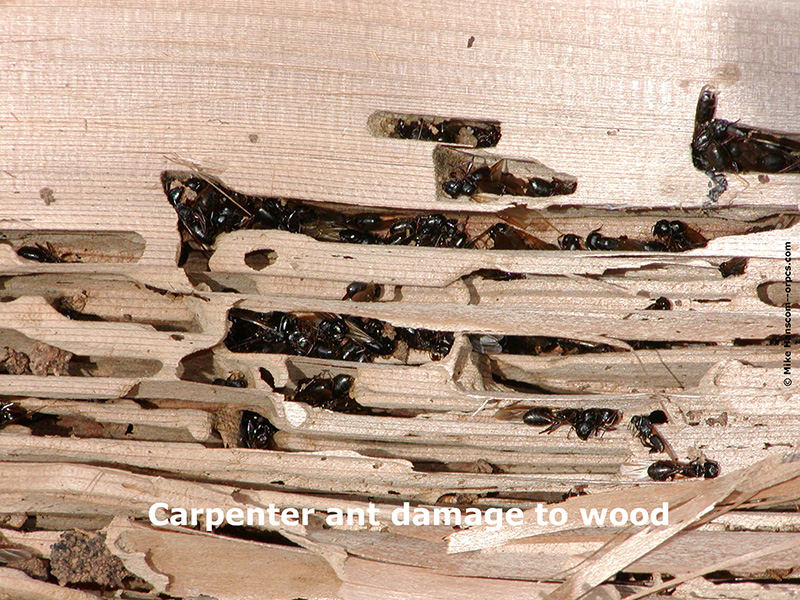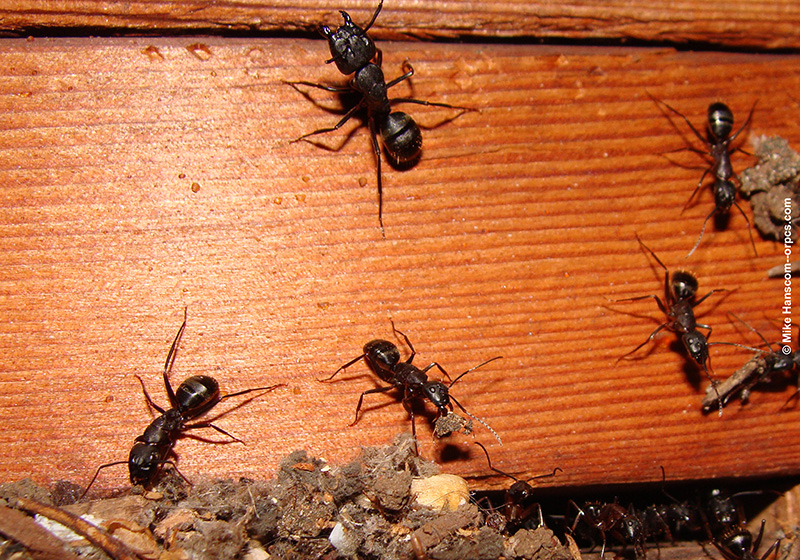Carpenter Ants
What are Carpenter Ants?

Clues that you might have them:
Small (or large) piles of sawdust under exterior siding, around windows, loose flooring or wood framing. Seeing them inside of the house—crawling or flying—or along the outside foundation is the most obvious clue.
If you leave them alone…
Carpenter ants can cause thousands of dollars in structural damage. They are the most visible—and the most intimidating—of wood destroying pests encountered in Oregon.
What you need to do about them:
Don’t ignore the presence of carpenter ants, especially if found inside of a building. Food for carpenter ants is outside, not inside, of a structure. If carpenter ants, (especially worker ants) are found inside, infestation in a structure is practically guaranteed.
When do I call Leupitz Pest Control?
Call Leupitz Pest Control immediately at (503) 362-8100 to confirm and eradicate the pests before they cause more damage to your home.
More Details
Unlike termites, carpenter ants do not eat wood. Instead, they bore or mine wood out to create galleries to nest in and expand the colony. In fact, oftentimes a structural carpenter ant infestation may exist in or adjacent to the insulation of a structure rather than wood. They do not always seem to care what kind of material they nest in as long as it gives them the protection they need to survive and a relatively close proximity to a food and moisture source. The danger in their presence, no matter where in the structure they presently nest, is the risk of these ants moving into the adjacent wood where they can proceed to cause extensive damage as they expand their nest into wood members.
Nearly a dozen different species of carpenter ants reside in the Pacific Northwest. They range in size from the small Camponotus essigi, (sometimes confused with other kinds of ants because of their small size) to the large Camponotus modoc and Camponotus vicinus; the reproductives sometimes found in excess of an inch in length. They can infest a structure by a singular fertile reproductive establishing a colony, which can take three to six years for the colony to mature. They can also infest a structure by an entire colony—whether a parent colony or a ‘satellite’ colony—moving from one location to another in a matter of hours (much as a swarm of bees might move from one place to another). They can be imported onto a property by delivery of organic landscape material from an infested site elsewhere or from firewood delivered from another area.
What can I do?
Prevention & Control
Don’t allow trees or shrubs to come in contact with the structure (either along the ground, siding, roof or overhead utility lines is vital). Elimination of moisture problems in and around the structure is important. Inspect firewood or landscape bark before delivery on the property, and do not allow such material to have contact with the exterior siding. In our experience, carpenter ants tend to give preference to such food sources as sugars produced from evergreen trees and shrubs, berry vines and bushes, ivy and other climbing and crawling ground covers. While they will also seek other food sources including other insects, most infested structures tend to have the aforementioned food sources in close proximity; thus attention should be given where possible to modifying such an environment to reduce the risk of infestation.
More Details
Unlike termites, carpenter ants do not eat wood. Instead, they bore or mine wood out to create galleries to nest in and expand the colony. In fact, oftentimes a structural carpenter ant infestation may exist in or adjacent to the insulation of a structure rather than wood. They do not always seem to care what kind of material they nest in as long as it gives them the protection they need to survive and a relatively close proximity to a food and moisture source. The danger in their presence, no matter where in the structure they presently nest, is the risk of these ants moving into the adjacent wood where they can proceed to cause extensive damage as they expand their nest into wood members.
Nearly a dozen different species of carpenter ants reside in the Pacific Northwest. They range in size from the small Camponotus essigi, (sometimes confused with other kinds of ants because of their small size) to the large Camponotus modoc and Camponotus vicinus; the reproductives sometimes found in excess of an inch in length. They can infest a structure by a singular fertile reproductive establishing a colony, which can take three to six years for the colony to mature. They can also infest a structure by an entire colony—whether a parent colony or a ‘satellite’ colony—moving from one location to another in a matter of hours (much as a swarm of bees might move from one place to another). They can be imported onto a property by delivery of organic landscape material from an infested site elsewhere or from firewood delivered from another area.


